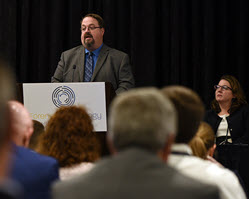Medical examiners
Firearm Injury Surveillance at the Local Level: From Data to Action
A Disaster Waiting To Happen
Forensic Pathology on Both Sides of the Pond, presented by Drs. Michael Baden and Peter Dean
Development of a Computer-Assisted Forensic Radiographic Identification Method Using the Lateral Cervical and Lumbar Spin
NIJ National Center on Forensics, Fiscal Year 2020
Assessing Cognitive Bias, Method Validation, and Equipment Performance for the Forensic Anthropology Laboratory
Application for Funding to Support the National Missing and Unidentified Persons System (NamUs)
Identification of Blunt Force Traumatic Fractures in Burned Bone
Blunt Force Trauma to the Ribs: Creating Predictive Models
Assessing Methods to Enhance and Preserve Proteinaceous Impressions from the Skin of Decedents during the Early Stages of Decomposition while Examining Environmental Variations across Seasons
Combining LC-MS/MS Product-Ion Scan Technology with GC-MS Analysis to Identify Drugs and Poisons in Postmortem Fluidsand Tissues
Subadult Ancestry Estimation Using Craniometrics, Macromorphoscopics, Odontometrics, and Dental Morphology
What You Can't Buy, Can't Kill You
Extraction and Quantification of Fentanyl and Metabolites from Complex Biological Matrices to Support Medicolegal Death Investigations
Optimizing the Analysis of DNA From Burned Bone Using Ancient DNA Techniques
Implementing NAGPRA: Connecting Medical Examiner and Coroner Offices to Tribal Partners
Searching for the Missing in a City of Millions
NIJ Journal Issue No. 264
Sexual Assault: Obtaining DNA From Evidence Collected up to a Week Later - Panel at the 2009 NIJ Conference
Technological advances have made it possible to detect male DNA in evidentiary samples collected several days after a sexual act has taken place. Panelists will present the research that has led to these findings, followed by a discussion of the potential impact of this work from the perspectives of the sexual assault nurse examiner (SANE) and the crime laboratory communities.
Funding Opportunities for Publicly Funded Crime Labs, Fiscal Year 2017
This webinar will inform the audience of the changes to three programs available for publicly funded forensic laboratories and introduce a new program for FY 2017. Changes to existing programs will be highlighted and presenters will discuss the background and goals of the solicitations, recommendations for successful applications, application expectations and requirements, the review process, and the application checklist. There will also be time for questions and answers at the end of the webinar.
Solicitations discussed include:
See the YouTube Terms of Service and Google Privacy Policy
A View From the Street: Police Leaders Share Their Perspectives on Urgent Policy and Research Issues
Sponsored by the International Association of Chiefs of Police (IACP) and its Research Advisory Committee (RAC), this panel unites law enforcement leaders from across the country to discuss their policy and research concerns. Charles Wellford, IACP RAC co-chair and University of Maryland professor, will facilitate the panel. Presenters will discuss urgent policing issues that merit ongoing research, law enforcement and academic research partnerships, and how research can and does affect agency policy and operations.


